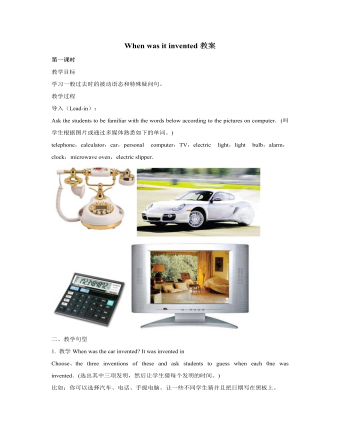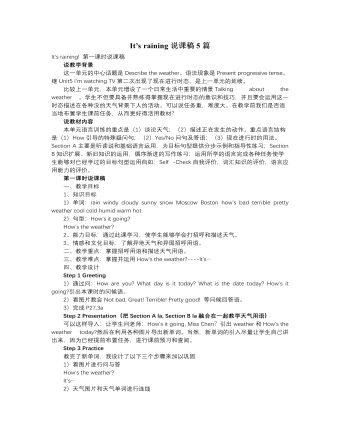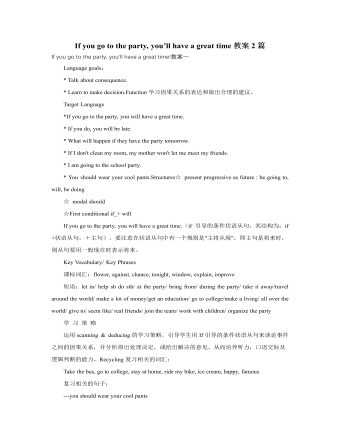人教版新目标初中英语八年级下册It’s a nice day, isn’t it教案2篇
-
- 页数:16页
- 字数:约 15904 字
- 大小:97.50KB
- 格式:.doc
- 版本:Office2016及以上版本
- 作者:Mu
It’s a nice day, isn’t it教案2篇
It’s a nice day, isn’t it?教案一
第一课时
"Hello! Welcome to English class!Introduce yourself. Meet your new classmates." Thats what the teachersays. What do you say? "Oh no!" It can be difficult talking to newpeople. But it can be fun, and you can make friends. How do you do it? Makesmall talk. Small talk is polite conversation. "Wang Nan is a greatpingpang player, isnt she?" "Id love to meet her, wouldntyou?" "Its been raining a lot, hasnt it?" Tag questions are aform of polite speech. To make small talk successfully, you should know how tomake them. You should also know what topics to talk about. Try to learn thisunit carefully. The next time youre in English class, youll find out. Makingsmall talks easy, isnt it?

(“你好!欢迎你!请做一下自我介绍。认识一下你的新同学。”通常在课上老师会这样说。你会说什么呢?“噢,不!”与陌生人谈话太困难了。但是这也很有意思,并且你还能交到朋友。你该怎么做呢?闲聊。闲聊指得是礼貌的对话。“王楠是一个很棒的乒乓球运动员,不是吗?”“我希望自己能认识她,你呢?“今年的雨水很多,不是吗?”反意疑问句是一种礼貌用语。为了使得谈话成功,你应该知道怎样去进行闲聊。你还应该知道与不同的人该谈论什么样的话题。认真的学习这个单元吧,下次在英语课上,你会发现与大家展开谈话是一件很容易的事情,不信我们来试试。)
一、学习目标
1.能使用反意疑问句有礼貌地与陌生人展开闲聊
2.能辨别哪些话题适合闲聊
3.能使用目标语言表示赞同或者反对
4.能比较熟练的写一封感谢信
5.了解中西方文化差异
二、学习内容
三、复习短语
go swimming去游泳
wait in line排队
hate doing sth.讨厌做某事
It looks like rain看上去要下雨了
wait for the bus/ train等车
I hope so/not.我希望如此/我不希望这样
so am / do I我也是
be late for/to迟到
四、布置作业
预习:Section A 1a,1b
第二课时
一.任务示范及讲解
同学们,你曾经与不认识的人聊过天吗?相信大家的答案都是肯定的,在生活中我们会遇到很多种与陌生人谈话的场景,这种谈话被称为闲聊,通常我们用英语与人交谈时用一个陈述句再加上一个简短的问句,便于打破僵局,展开谈话。大家想想看一般在什么情况下,我们与自己不认识的人攀谈?
Sample one:
on a bus, wait in a movie line, at the bus stop or trainstation, at the concert, in a restaurant, at the park, etc.
A: It’s a nice day, isn’t it?
B: Yes, it is.
A: The train is late, isn’t it?
B: Yes, it is.
A: It looks like rain, doesn’t it?
B: Yes, it does.
Sample two:
成功的对话应该是谈话的双方都需要问问题以便谈话能够继续,在我们上节课2a的录音当中,第一、二段对话是不成功的,而第三段对话因为双方都在不停的找话题从而使得谈话得以顺畅的进行。
请大家参照2b中的对话,想象一下现在是你在车站等车,你怎么开始与车站上不认识的人交谈呢?请同学们把这段对话写下来。
可供参考对话:
A: It’s really cold today, isn’t it?
B: Yes, it is. I hope the bus comes soon.
A: I do, too, but it’s always late on Sunday.
B: Oh, I didn’t know that. I usually take the bus on weekdays.
A: Well, do you take the bus to school?
B: Yes, I do.
Sample 3: Complete the conversation. Writesentences in the blanks.
同学们,请阅读下面的文字材料,然后完成对话。
A: This is great weather, isn’t it?
B: It sure is. But it’s a little hot for me.
A: Oh, I love hot weather._______________________________________.
B: Which beach are you going to?
A: I’m going to Today Beach. __________________________.
B: I usually go to Sandy Beach.
A:___________________________________________________.
B: No, it’s never crowded. Well, have a good day!
A: __________________________.
B: Goodbye.
Possible answers:
A: This is great weather, isn’t it?
B: It sure is. But it’s a little hot for me.
A: Oh, I love hot weather. I’m going to thebeach today.
B: Which beach are you going to?
A: I’m going to Today Beach. Where do youusually go?
B: I usually go to Sandy Beach.
A: Is it very crowded?
B: No, it’s never crowded. Well, have a good day!
A: Thanks. Goodbye.
B: Goodbye.
Sample 4:
1. 请同学们看78页4,图中的这些人分别是谁?你们通常在什么地方能够遇到他们,请想一想什么样的话题比较适合与他们进行交谈。完成下列表格。(possible answers are given below.)
2. 请选择表中的一个人物写一段你与他之间的对话。
I want to make a conversation with an old man.
(possible conversation given by teacher)
(At the park)
I: It’s a nice day, isn’t it?
The old man: Yes, it is. It’s good for a walk, isn’t it?
I: Yes. Do you often take walks in the park?
The old man: Yes, I take a walk everyday in thepark.
I: Great. Have a good day.
The old man: You too. Goodbye.
I: Goodbye.
二.布置作业
1.完成P78 3b
2.完成sample 4中的一个对话。
3.听P79 Section B 2a 和2b
第三课时
一.任务示范及讲解
Sample 1
Every year
there are some new students in your school. Thinkof things they can talk about in the hallway, in the classroom, in thecafeteria, or on the playground. Finish the article below to offer help andgive advice.
1.每年你们学校都会转来新同学,请为新生写一封信,给他们一些能够很快融入集体的建议及谈话指南。
Small talks for new students:
Dear new schoolmates,
Welcome to our school. I’m so glad that you are hereand are you shy meeting new people? …
Sample 2
Plan for your journey
同学们,暑假就要到了,你们有什么打算呢?通常暑期是一个出游的好机会,想一想你最想去哪里?这个暑期你将有一个机会去英国,临行之前请你想想你应该做哪些准备?你最想知道哪些关于英国的情况?
1.Now, please make a list about things you wouldlike to know about Britain.
____________________________________________________________________
____________________________________________________________________
(possible answers: weather, transportation,geography, history of the city you are going to live, popular sports in France,etc.)
2.Think about what kind of topic you wouldprobably like to talk about with the following Englishmen.
3. Please choose a topic and make a dialogue fromthe above chart.
Sample answer:
You: David Beckham is really good, isn’t he?
Kid: Yes, and he’s quick.
You: Do you like sports?
Kid: Yes, I do. What about you?
You: I do too. What kind of sports do you like?
Kid: I like soccer.
You: Oh, I like basketball.
作业: 完成Workbook 中的练习题
第四课时
一.阅读P80页3a的三段短信,检查是否对文章有一定的了解。
Thank-you letter note for a gift: 3
Thank-you letter note for a party: 1
Thank-you letter note for help: 2
二、完成任务
1. Write a thank-you note
Step 1 When do you send gifts?
When my friends’ birthday is coming.
When it’s a holiday.
Step 2 What are the kinds of parties you knowabout?
Birthday party, new year party, Christmas party,weekend party, etc.
Step 3 What do you write a thank-you note for?
Thank-you note for a gift, for a party or for help.
Step 4 Please read the three situations givenbelow and think about what kind of thank-you note you could write. Choose oneto write a thank-you note please.
Situation 1 Your friend Jimmy has invited you tothe party and you have had a good time during the party.
Situation 2 You are a new student in a new school.Your classmate Sally has helped you a lot. With her help, you get used to theschool soon.
Situation 3 It’s new years day. You have receiveda gift from your grandma. What a lovely koala! You love it so much.
Situation 1 __________Situation 2_____________
Situation 3 ______________
Sample letter given by teacher: (Situation 1)
Dear Jimmy,
Thanks for inviting me to your birthday party. Itwas great. I had a lot of fun and it was good to see all the old friends duringthe party. I have made some new friends, too. I am looking forward to the nextparty.
Dick
作业:
Now, you are studying at home because of SARS, butthe teachers are still busy working in the campus. Your parents are stillworking. And all the adults are still working in different areas, especiallydoctors and nurses, they are fighting against SARS. Do you feel grateful tothem? Do you want to write a letter to any of them? Please write a thank-younote.
Sample letter:
Dear teachers,
Long time no see. How are you? I miss you so much.We’re …
It’s a nice day, isn’t it?教案二
1 单元教学内容分析
本单元以描述与陌生人聊天时应注意的事项为话题,学会如何选择话题、展开话题,进行流畅沟通的主题,最后落实到把握如何成功地与陌生人交流,并且熟练掌握各种不同内容的感谢信的写法。Section A 部分重在从听、说、写三方面强化对在不同场合下和陌生人聊天的表述,感知反意疑问句结构;Section B部分则进一步深化了这个主题,从识别、对话、书写等方面提出了更高的要求。由口头的闲聊到正式的格式文体——感谢信的书写,引导学生思考如何由和陌生人闲聊到在真实的交际礼仪中了解、关心、感谢别人并增进友谊的方法。
3 单元教学目标
1.掌握重点词汇和重点语法:
(1)重点词汇:noon, bookstore, elevator, traffic, cross, low, slow, fan , note, comealong, get along, at least, look through
(2)重点句型(反意疑问句)
It’s really windy today, isn’t it?Yes, it is.
You’re Ben’s sister, aren’t you?Yes, I am. / No, I’m not.
The NO.5 bus stops here, doesn’t it?Yes, it does.
2.学会与人搭讪,能写感谢信。
3.了解中西方文化差异。
三、教学重点和难点
1. 重点:(1)在特定场合中选择适当的话题与人搭讪
(2)写不同内容的感谢信
2.难点:理解前肯后否和前否后肯反意疑问句的不同回答。
三、课时安排:
period 1: Section A 1a-2b
period 2: Section A 2c、3a、3b、4
period 3: Section B 1a-2c
period 4: Section B 3a、3b、3c
period 5: Section B 4a, Self-check
Period 1(Section A 1a-2b)
2 教学目标
1.掌握be动词、助动词do和does的前肯后否反意疑问句
It’s really windy today, isn’t it?Yes, it is.
You love violin music, don’t you?Yes, I do./No, I don’t.
The NO.5 bus stops here, doesn’t it?Yes, it does.
1.学会在车站、影剧院、商店等不同场合与人搭讪。
2.能判断闲聊的成功与否,从而学会如何与人闲聊。
二、重点、难点
1.重点:在不同的情景中,选择合适的话题与人闲聊。
2.难点:编情景对话
三、教学策略
呈现特定情境中人们闲聊的技巧,让学生模仿,并进行听力训练,让学生学会如何判断闲聊的成功与否。
4 教学步骤
Step 1. Lead in by introducing Labixiaoxin’s small talk!
T: Labixiaoxin is traveling in England. How does he talk with foreigners,the people he doesn’t know? Let’s look.
Situation 1: Wait for the subway
T: Now he’s at the subway station, waiting for the subway. He meets aforeigner,what does he say?
S1: Hi. How are you?
S2: Nice to meet you.
S3: What’s your name?
T: But in England, when people meet, they often talk about the weather.
Eg: It’s really windy today, isn’t it?Yes, it is.
It looks like rain, doesn’t it? Yes, it does.
It’s a nice day, isn’t it?It sure is.
Ok, are you clear? Now let’s practice. Act as Labixioaxin and theforeigner.
Situation 2: The subway is late.
T: Labixiaoxin has been waiting for a long time. But the subway doesn’tcome.
So the foreigner says,“The subway is late, isn’t it?”
How should Labixiaoxin answer?
S: Yes, it is. / It sure is.
T 引导学生展开话题:It is always late, isn’t it? No, but sometimes.
The line is moving slowly, isn’t it?
Situation 3: In the subway
T: There are many people in the subway. It’s very crowded. So he says:“The subway iscrowded, isn’t it?”
Situation 4: On the concert
Labixiaoxin: You love violin music, don’t you?
Foreigner: Yes, I do.
L: He plays really well doesn’t he?
F: He sure is.
教师引导学生展开话题:Do you have his new CD?
Step 2. Pairwork
Practice all the situations above.
Step 3. Practice
Situation: Two people are waiting in line for the bus.
It’s a nice day, isn’t it?
The bus is late, isn’t it?
This line is moving slowly, isn’t it?
Do you think it’s going to rain?
(…have been waiting for twenty minutes, forgot to bring umbrella…)
Step 4. Listening 1b
After listening , the students practice the conversations.
Step 5. Listening 2a、2b
T: To have successful small talk , both people need to ask questions.
1. Listen to three conversations.Are they successful or unsuccessful. Write“S”or“U”.
2. Then listen and do 2b.
3. Point out the new phrase: bynoon
Step 6. Make successful small talks
Situation 1: Two people are watching NB A.
Useful expressions:
It’s really exciting, isn’t it ?
You love basketball, don’t you?
You like Yao Ming, don’t you?
I watch NBA every week.
How often do you watch NBA?
Situation 2: Two people are waiting for the bus at the bus stop. (Section A3a)
Step 7. Homework
1.读听力材料P921b5遍
2.作业本(1)P43
Step 8. 教学反思
Period 2(Section A 2c、3a、3b、4)
4 教学目标
1.学会在车站、电梯、书店、街上等不同场合与人搭讪。
2.结合实际生活,学会选择适当的话题和人闲聊。
二、重点、难点
1.重点:编情景对话
2.难点:如何正确选择话题
4 教学策略
以在车站等车的场景为例,指导学生在大胆说的基础上,进行书面表达,选择一些贴近学生生活的情境(如:waiting in line to buy ice cream, two people alone in an elevator)指导学生如何选择话题编情景对话,从而在实际应用中真正掌握与人闲聊的技巧。
四、教学步骤
Step 1. Review
Step 2. Play a game
Work in pairs, choose a number. Then make a small talk .
Situation 1: Looking through(浏览) books in a bookstore(书店).
Situation 2:waiting to cross(穿过) a busy street.
Situation 3:Two people alone in an elevator(电梯).
Situation 4:Waiting for rain stopping
Situation 5:Waiting for a train
Situation 6:Waiting in line to buy ice cream.
Situation 7:Visiting an exhibition
您可能喜欢的文档
查看更多
人教版新目标初中英语八年级下册It’s a nice day, isn’t it说课稿6篇
- 页数:23页
- |大小:130.00KB

人教版新目标初中英语七年级下册It’s raining教案2篇
- 页数:5页
- |大小:70.50KB

人教版新目标初中英语八年级下册Why don’t you get her a scarf教案
- 页数:13页
- |大小:86.00KB

人教版新目标初中英语九年级下册When was it invented教案
- 页数:12页
- |大小:586.50KB

人教版新目标初中英语七年级下册It’s raining说课稿5篇
- 页数:21页
- |大小:144.50KB

人教版新目标初中英语八年级下册If you go to the party, you’ll have a great time教案2篇
- 页数:25页
- |大小:200.00KB

人教版新目标初中英语七年级上册What color is it教案
- 页数:6页
- |大小:56.00KB
热门课件教案

县综合行政执法局2023年工作总结和2024年工作计划
- 页数:8页
- |大小:28.37KB
- 课件教案

2023年区实施乡村振兴战略工作总结
- 页数:6页
- |大小:27.90KB
- 课件教案

交通运输局在巡回指导组主题教育阶段性工作总结推进会上的汇报发言
- 页数:4页
- |大小:33.41KB
- 课件教案

XX区民政局党支部开展主题教育工作情况总结报告
- 页数:3页
- |大小:24.47KB
- 课件教案

镇2023年工作总结和2024年工作谋划
- 页数:6页
- |大小:31.68KB
- 课件教案

XX区文旅体局2023年工作总结 及2024年工作安排
- 页数:8页
- |大小:32.41KB
- 课件教案
今日更新

5月份主题教育工作情况总结汇报
- 页数:3页
- |大小:136.87KB

××县招商局2024年上半年工作总结
- 页数:12页
- |大小:142.54KB

×××公安局机关党委上半年党建工作总结
- 页数:7页
- |大小:186.25KB

《2019—2024年全国党政领导班子建设规划纲要》实施情况的工作总结3800字
- 页数:6页
- |大小:29.16KB

“转观念、勇担当、新征程、创一流”主题教育活动阶段性工作总结
- 页数:3页
- |大小:22.76KB

“四零”承诺服务创建工作总结
- 页数:5页
- |大小:39.83KB











